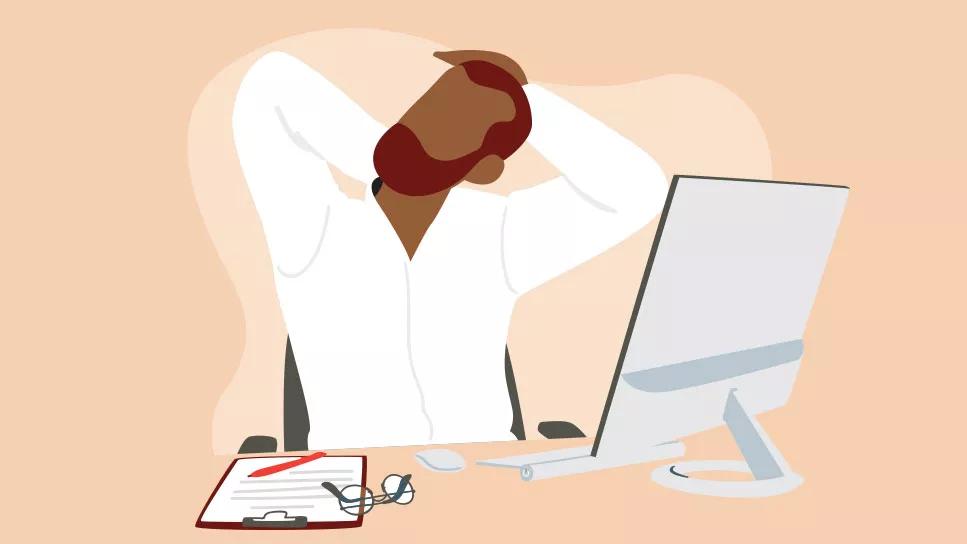Simple exercises like wall angels and pelvic tilts can help keep your body in an optimal position — and help undo years of improper posture habits

If your shoulders are rounding, your back is slumping or your head is drooping, it’s time for a change. Because poor posture can be a real pain in the neck (not to mention the back, shoulders, arms and more).
Advertisement
Cleveland Clinic is a non-profit academic medical center. Advertising on our site helps support our mission. We do not endorse non-Cleveland Clinic products or services. Policy
That’s especially true because, as the old song goes, the head bone’s connected to the neck bone; the neck bone’s connected to the shoulder bone; the shoulder bone’s connected to the backbone... And so on and so on.
Improper posture in just one area of your body can lead to aches, pains and weaknesses in other areas.
“If you imagine a straight line coming down from the ceiling, it should hit you in your ear lobe, the tip of your shoulder and the side of your pelvis. If you’re standing, it also should go through your knee and the outside part of your ankle,” says physical therapist and certified athletic trainer Jennifer Danzo, DPT. “And if anything deviates from that straight line, that’s where extra forces or pressures are being placed on your body.”
Dr. Danzo shares some go-to posture exercises to help you sit and stand straighter and ease the aches and pains.
Remember when you were a kid and the adults in your life told you to “stop slouching” and “stand up straight”?
You probably rolled your eyes at the time. But they were on to something. Years of slouching, rounding and slumping take a big toll.
Maybe you’ve been working your desk job from the couch or the kitchen table these days. (Not exactly the ideal ergonomic setup). Or years of working on your feet have led to some bad habits, like shifting your weight to one side or swayback. Or maybe it’s too much time looking down at your phone that’s giving you a case of “text neck.”
Advertisement
You need to be diligent to correct years of bad posture. But certain exercises and stretches can help.
“We have natural curves to our back that are supposed to be there,” Dr. Danzo shares. “We have an inward curve at our neck. An outward curve around the shoulder blade level. And another inward curve at your lower back. If we’re slouching, we reverse all those curves. And that’s where the extra stresses get placed.”
Exercising can help lengthen and strengthen the muscles that will help keep your body in an optimal, natural position. Try these posture exercises to get your body back in line.
One way to see where your posture is going wonky is to stand with your back against a wall.
“If you’re standing straight with good posture, the back of your head as well as your shoulder blades, hip and back of your legs should all touch the wall,” Dr. Danzo advises.
Use the wall to support you as you position your body so you’re flush against it. Pull your head back. Roll your shoulders. Tuck your pelvis. Take your time to really feel what it’s like to be in proper posture.
It may feel uncomfortable or unnatural at first. That’s OK.
The more you practice, the more natural it’ll start to feel. And the more you’ll start to recognize when you’re letting old posture habits take over.
Remember when you were a kid and you would lie out in the fresh snow and wave your arms up and down to make a snow angel?
A similar move can help to stretch your arms and chest muscles to help correct your posture.
Here’s how to do it:
You can also try this exercise lying on the floor with your legs straight.
One common posture mistake people make is a “head-forward posture.” As in, your head hangs out too far in front of your shoulders.
“When our head gets forward, the weight of the head is pulling on the muscles in the back of the neck and puts extra stress on those muscles,” Dr. Danzo explains. “So, the muscles in your chest get tight and your shoulders start to round forward.”
Advertisement
To counteract all that, practice moving your head back into position. While sitting, carefully pull your chin backward, without changing your eye level. That is, don’t look up or down. You can use your fingertips to gently coax your chin back and hold it there for several seconds at a time.
Not sure if you’re doing it right? Try doing it while standing with your back against the wall. Focus your eyes on a spot in front of you at a comfortable eye level and pull your head back until it touches.
Flexibility and strength in your upper chest muscles are key to keeping your shoulders from rounding forward.
Give those muscles a good stretch with this posture-correcting exercise.
Strengthening your upper back can also help to keep your shoulders from rolling forward and putting pressure on your back.
Advertisement
One exercise to help strengthen your upper back is a standing row. This can be done with a set of resistance bands if you have them. (Or just imagine pulling on invisible rubber bands if you don’t have a set handy.)
Attach the middle of a resistance band to a doorknob. Hold one end of the band in each hand. Bend your elbows and squeeze your shoulder blades as you draw the band back.
“I tell people to graze their ribcage with their elbows. As you pull your elbows back, they should be close to your sides,” Dr. Danzo advises. “Don’t pull your elbows up high, as it can cause a pinch in your shoulders.”
Training your body to keep your shoulders back is a vital part of improving poor posture.
Dr. Danzo suggests this exercise:
Lie on your back with your knees bent. Keep your arms at your sides and your palms facing the ceiling. Push your shoulder blades down and back, sinking them to the ground.
“Pinching the shoulder blades helps to strengthen the back,” she adds.
Your lower back is another victim of poor posture.
“Your lower back should have a little inward curve. But if your lower back is tight or weak, the natural curve can become exaggerated,” Dr. Danzo shares.
That’s called lumbar lordosis, or swayback. It’s when your belly pushes forward and your butt sticks out behind you. When you’re lying down, you’ll notice there’s a bigger gap than normal between your lower back and the floor.
Advertisement
Pelvic tilt exercises can help to counteract that.
Here’s how to do it:
It may take a few tries to find what a good forward tilt for you feels like. The goal isn’t so that your lower back has to completely touch the floor. (Remember, there should be some natural curve there.) But you want your back close to the ground and not arched.
Keeping your neck muscles strong and flexible can help to hold the weight of your head, and keep it from drooping.
Help stretch the side of your neck with this stretch you can do from your desk chair.
Correcting improper posture takes practice. After all, you stand and sit as you do because that’s what’s become comfortable. It’s where your muscles are used to being — even if it’s not good for them.
So, becoming more aware of your posture and correcting it consistently throughout your day is key.
“You might consider setting a timer as you work to go off every 10 minutes or so just as a reminder to check in with your body,” Dr. Danzo suggests. “Taking a moment to resituate yourself and hold a good posture can remind you of where you’re supposed to be.”
Remember, too, to practice good ergonomics when you’re sitting at your desk. That means your feet are on the floor. Your monitor is at your eye level. And your keyboard and mouse at a comfortable height that allows your shoulders to stay lowered.
You may have seen posture training gadgets online or in your local drugstore. Some are like harnesses that you wear around your shoulders to encourage them to stay back. Others are little digital devices that buzz or vibrate to tell you when you’re slouching.
Dr. Danzo’s take on these products?
“I discourage people from using passive devices, like harnesses,” she says. “As soon as you take them off you’re not going to get any benefit from them.”
As for the digital posture reminders, Dr. Danzo shares that she’s seen some people have success with them. And because they encourage you to make changes to correct your posture, rather than a piece of material that’s doing it for you, they can train you to know what good posture feels like so you can keep up with it.
Good posture is important to keep your neck, back and shoulders strong and ache-free. If you’re worried that poor posture is contributing to your pains and exercises aren’t helping, talk with a healthcare provider, like a primary care physician or a physical therapist. They can help to pinpoint where you’re tight, where you have weakness and how to get you standing and sitting a little straighter.
Learn more about our editorial process.
Advertisement

A chiropractor offers guidance and simple exercises

This gentle yoga stretch supports your spine, strengthens your core and calms your mind

Shoulder rolls, hamstring stretches and calf exercises can all improve flexibility and endurance

Physical activity can help preserve and improve your cognitive function and fend off dementia, stroke and other health concerns

Lower-intensity workouts can deliver high-quality health and fitness results

Incremental changes in your exercise routine can improve your strength and endurance over time

Understanding heart rate zones can help you tailor your workout to reach your goals

Increase the size of your muscles by bulking up on protein and focusing on slow, intense movements with progressive overloading

Babies can get congested easily, but you can calm their cough by keeping them hydrated, using nasal drops and running a humidifier

Weight loss may cause loose, sagging skin and muscle loss to your rear

Several conditions, like vitiligo and fungal infection, can cause a loss of pigmentation, leading to white spots or patches on your skin